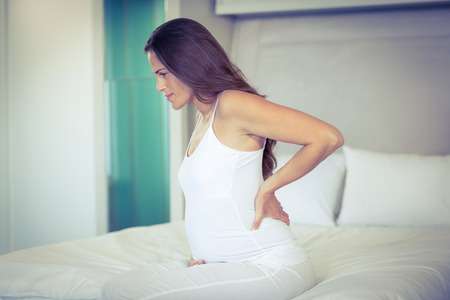Aches and Pains in Pregnancy

In this article, you will find:
Back, pelvic, and abdominal pain
Backaches
Lower generalized backaches are extremely common during pregnancy, particularly in the third trimester; around two thirds of all pregnant women suffer from backaches.
Causes
As pregnancy progresses, the increased weight of your abdomen tends to pull on the lower spine so that it curves inward and your center of gravity shifts forward. As you try to correct this, you may strain the lower back muscles. In addition, pregnancy hormones soften your ligaments, causing them to stretch and provide less support for your back.
What to do
Maintaining good posture and avoiding tilting your pelvis forward helps relieve pressure on your back and helps both prevent and alleviate backaches. Regular, moderate exercise to keep your muscles toned and supple is also beneficial. See Strengthening and Toning Exercises and Abdominal Exercises for suggested exercise routines. Yoga, pilates, and water aerobics are also recommended.
Try to avoid standing in one position for too long and vary your daily tasks, if possible breaking them down into shorter stints. If your work involves standing or sitting for long periods, take regular short breaks, and while sitting, make sure your lower back is supported. Avoid lifting heavy objects.
Massage and warm water can help relieve backaches. If back pain is particularly troublesome, talk to your doctor about wearing a supportive maternity belt.
Pelvic girdle pain, or PGP
Also known as symphysis pubis dysfunction, pelvic girdle pain (PGP) refers to discomfort and pain felt in the pelvic area and groin. The pain may be concentrated in the buttocks or travel down one leg, and for this reason is sometimes mistaken for sciatica. PGP is often worse when doing activities such as walking or going up stairs; it may also be troublesome at night, but this is usually related to activities done during the day. PGP is most common toward the end of pregnancy and may range in severity from mild to serious enough to need a walking aid.
Causes
Various factors may contribute to PGP. The pelvis is made up of three bones: the sacrum and the two iliac (hip) bones. The bones are connected at the front by the symphysis pubis joint, and at the back by the sacroiliac joints. The joints are stabilized by ligaments and usually move very little. During pregnancy, however, ligaments soften and stretch more easily so that there is more movement at these joints. This results in instability of the pelvis. In addition, postural changes due to the enlarging abdomen may mean that one joint is more mobile than the other, putting extra strain on the joints. The result is inflammation of the joints and discomfort or pain.
What to do
If there is increased movement in one side of your pelvis, a pelvic support belt may be recommended, which often gives instant relief. You may be referred to a physical therapist who will show you how to modify everyday activities, such as walking and getting up, in order to avoid pain, and may also recommend abdominal and Kegel exercises. Acupuncture can help relieve pain, and prenatal water aerobic classes are helpful. Preventative measures include avoiding activities that cause pain, and avoiding heavy lifting, lying on your back, and sustained periods of activity. It's also important to get plenty of rest.
Round ligament pain
The two round ligaments run from the top of the uterus on either side and attach to the side walls of the abdomen. As the uterus enlarges, the round ligaments gradually become stretched, which can cause an ache or brief, sharp pain on one or both sides of the lower abdomen or in the groin. Round ligament pain usually starts during the second trimester.
What to do
See your doctor, who will rule out other causes for the abdominal pain. Once you have been reassured, you should find it easier to deal with the pain. When you have an episode, try to rest and relax. Lying on your side and bringing your knees up toward your chest may be helpful, as can taking a warm bath.